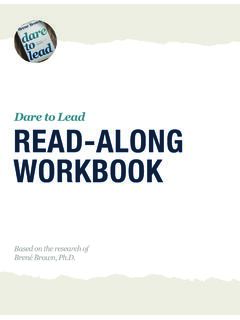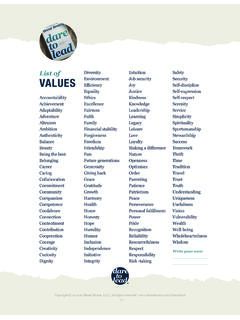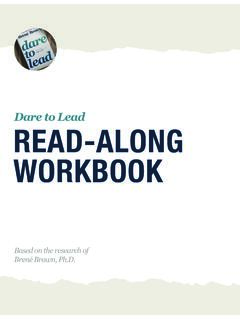Transcription of The Dare to Lead Glossary KEY LANGUAGE, SKILLS, TOOLS, …
1 KEY LANGUAGE, skills , TOOLS, AND PRACTICESThe Dare to Lead GlossaryAccountability You own your mistakes, apologize, and make amends. Part of the BRAVING acronym for Back-channeling is a term that describes a broad range of behaviors that all share in common not being direct or upfront with people. The opposite of back-channeling is upfront or direct communication. Back-channeling includes sharing our reactions, emotions, or opinions with people before or after a meeting, rather than sharing them in the meeting. I think this is a terrible idea. I don t think he knows what he s talking about. In the meeting this afternoon, I m going to suggest that we kill the project will you support me? Other terms for back-channeling include the meeting after the meeting, gossip, and the dirty yes (where I say yes to your face and then no behind your back). The goal is to develop a culture where back-channeling stops because people have the courage to have hard conversations and refuse to participate in effect Feeling like you have to hop on-board with the consensus, even if you might disagree, vehemently or mildly.
2 This often happens when you re the only objector or you re the last to share and the group is already excited about an Setting boundaries is making clear what s okay and what s not okay, and why. Setting boundaries is vulnerable and brave. A - BCopyright 2018 by Bren Brown, LLC | All rights reserved | Failure to set boundaries can quickly lead to resentment. Leaders should model appropriate boundaries, and all team members must take responsibility for establishing their own boundaries and respecting the boundaries set by others. Examples of appropriate boundaries might include starting all meetings on time, not checking or responding to emails after a certain time in the evening, or not taking work home on weekends. When we asked people why they hesitate to set boundaries, the number one answer that emerged from the research was, I don t want to make people mad, disappoint others, or make them stop liking me.
3 The number two reason was related to the first, I don t know how to set boundaries without sounding selfish or unlikeable. What s really interesting is that when we asked the same participants to describe or explain the consequence of not setting boundaries, the overwhelming response was resentment. Followed by anger. Followed by frustration. These emotions eat away at our individual and collective confidence and trust. They lead to people talking behind each other s backs and to blame. This is why daring leaders set, hold, and respect boundaries. Even when it s hard. We often feel like we need to apologize or justify when setting a boundary. We don t. And, likewise, it s not your team s job to make you feel better or more comfortable setting a boundary. Just be clear, respectful, and open for questions. Most of the time, people will be thankful for the clarity and appreciate the rarity of seeing someone ask for what they need rather than be passive aggressive or pissed off.
4 Part of the BRAVING acronym for breathing or Tactical breathing Box breathing, also called tactical breathing, is the reckoning tool to use when staying with emotion (instead of offloading it) and cultivating calm. Box breathing consists of four simple steps:01. Inhale deeply through your nose, expanding your stomach, for a count of Hold in that breath for a count of Slowly exhale all the air through your mouth, contracting your stomach, for a count of Hold the empty breath for a count of Inventory The acronym BRAVING breaks down trust into seven elements: Boundaries, Reliability, Accountability, Vault, Integrity, Nonjudgment, and 2018 by Bren Brown, LLC | All rights reserved | Boundaries Setting boundaries is making clear what s okay and what s not okay, and why. See also Boundaries for more information. Reliability You do what you say you ll do.
5 At work, this means staying aware of your competencies and limitations so you don t overpromise and are able to deliver on commitments and balance competing priorities. Accountability You own your mistakes, apologize, and make amends. Vault You don t share information or experiences that are not yours to share. I need to know that my confidences are kept, and that you re not sharing with me any information about other people that should be confidential. Integrity Choosing courage over comfort; it s choosing what s right over what s fun, fast, or easy; and it s practicing your values, not just professing them. Nonjudgment I can ask for what I need, and you can ask for what you need. We can talk about how we feel without judgment. We love to judge other people, because it feels so, so good, in that moment, to feel superior. But the bitter irony is that, based on research, we judge in areas where we re most susceptible to shame, and we judge people who are doing worse than we are in those areas.
6 If you find yourself being incredibly judgmental around a specific issue appearance, parenting, gossip then it s a clue that it s a difficult issue for you. We don t judge in areas where we feel a strong sense of self-worth and grounded confidence, so the more you can focus on building yourself up in areas where you feel weak and exposed, the more you can operate from a place of full empathy including toward yourself. Generosity Extending the most generous interpretation to the intentions, words, and actions of others. The assumption of generosity is believing that people are doing the best that they 2018 by Bren Brown, LLC | All rights reserved | The BRAVING Inventory can be used as a rumble tool a conversation guide to use with colleagues that walks us through the conversation from a place of curiosity, learning, and ultimately The definition of calm is creating perspective and mindfulness while managing emotional reactivity.
7 Calm is a daring leadership superpower because it heals anxiety and creates the space we need to become emotionally grounded. This, in turn, prevents us from managing anxiety by over- or underfunctioning. In tense situations, in order to respond calmly (rather than react), sometimes all it takes is counting to ten. Calm is contagious, and it can be modeled to lessen group back Circling back gives us the opportunity to revisit a conversation or interaction after we ve had time to fully process. I need to think about this. Can we circle back in an hour? We may need to circle back if we need more information or clarification. Can we circle back on the decision to move the project date? I ve got some questions. We might want to circle back to make amends for something we did or for not fully listening. I don t like how I showed up in that meeting. Can we circle back? Sometimes in the middle of a difficult conversation you find yourself feeling defensive or needing time to think.
8 It can be helpful to request a time out with a circle back in a specific period of time. This signals that you re considering the conversation carefully rather than rushing to placate or dismiss what s being said. I think I need a time out. Can we circle back and finish up this conversation in a couple of hours?Clear is kind. Unclear is unkind. Sometimes speaking the truth feels like we are being unkind, especially when sharing difficult information or feedback. But in reality, dancing around the truth is unkind. When we avoid stating the truth when we are vague or ambiguous under the guise of being kind it is often because we are trying to lessen the discomfort for ourselves, not for the other person. Direct, honest, straightforward communication is kind. Sidestepping the truth doesn t serve a useful purpose for anyone 2018 by Bren Brown, LLC | All rights reserved | suffering Comparative suffering is a race to misery where some people believe they inherently win (I hurt more than anyone could possibly understand) or don t deserve to be in the marathon at all (I m embarrassed that I m upset, because worse things happen to other people).
9 It hinges on the false belief that empathy is finite. Fortunately, the opposite is true empathy is not only infinite, it is renewable. The more empathy we infuse into our relationships, organizations, and culture, the more there is to go around. Confabulations A confabulation is defined as a lie told honestly. To confabulate is to replace missing information with something false that we believe to be theories Stories based on limited real data and plentiful imagined data, blended into a coherent, emotionally satisfying version of reality, are called conspiracy Building or Safe Container Container building (building a safe container) is the process of establishing the ground rules of a group what rules need to be in place for people to feel safe to communicate and to freely express their ideas and concerns? Taking the time to create a safe container builds trust and improves communication.
10 It provides an atmosphere where team members can be vulnerable and take risks. The best way to establish these rules is to ask the team members what they need to feel open and safe. Consolidate the answers and post them in plain sight. Point out when people aren t following the rules. One question we often get asked is How often do we need to do container building in our teams? We found that if you invest the time to write up an agreed upon list of ground rules that emerge from a session of container building ( , What does support from the group look like?, What s not okay?, etc.), you can post it where you meet and just check in to see if anyone has something to add. Or, you can periodically ask the team if they think it s time to rumble on it again. If a tough or sensitive issue emerges in your group ( , someone is leaving, there are big changes or a team setback), revisit the safe container list and definitely start with permission slips.







